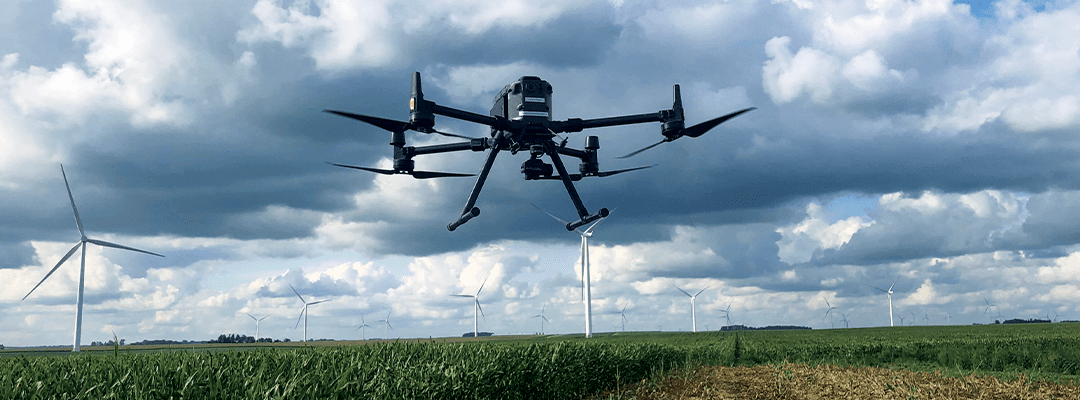The past few years have been nothing short of difficult for agronomists worldwide. From less-than-ideal weather to labor shortages, costs have seemed to rise where resources and productivity have plummeted.
For boots-on-the-ground crop scouters, this labor shortage has resulted in more scarce and costly resources. This shift has left technology to pick up the slack productivity-wise. Drones come into play to boost productivity on all levels for agronomists. Ag drone systems provide faster, accurate data collection while capturing data points at greater masses – all while utilizing fewer resources.
The Anatomy of Drones: Multirotor vs. Fixed-wing
With drones coming in all shapes, sizes and prices, it’s important to understand how they differ. Like with nearly every rule of thumb – cheaper is not always better. Diving into the specifics that ultimately determine pricing is important to ensure all needs are being met. With significant size variations, it is essential to understand the factors that play into drone size preferences:
- Weather, can the drone withstand wind and other weather-related variables?
- Restrictions, how difficult is it for the drone to navigate the climate?
- Endurance, will battery life prevail the time spent in the field?
- Field size, how many trips will it take for the drone to cover a larger field?
A lot of these factors are broken down into the differences between fixed-wing drones and multirotor drones. Fixed-wing drones’ higher endurance allows them to fly larger and even multiple fields, where multirotor drones lack endurance and have the potential for needing multiple batteries to complete data capture. This higher endurance also allows fixed-wing drones to capture data faster – providing optimal efficiency for agronomists needing to conquer more acres in less time.
Multirotor drones tend to be smaller in size so are quick and nimble while remaining low in cost, making them good starter drones. They are top candidates for smaller, more difficult to navigate fields due to their ability to fit tighter spaces and quickly navigate areas. Although they are quicker, their battery life slows them down by limiting the number of acres covered per hour.
If you are looking to fly larger fields, paying more is essentially investing in more efficient data capture. Multirotor drones simply do not have the assets to compete with fixed-wing drones in productivity and efficiency.
Interested in digging into the differences between drone types? Check out our Twitter Space with Sentera’s Aerospace Engineer, Matt Skelton.
The Power of Ag Sensors
Drone types also impact the sensors they integrate with, which can be crucial in collecting data. Similar to drones, sensors have their own areas of expertise. Sensors perform best in different times of season due to vegetation growth and what the sensors were developed to capture.
RGB |
NDVI |
NDRE |
| Full Season | Early-to-mid Season | Mid-to-late Season |
| Full field mapping and analysis | Density and greenness of field vegetation | Chlorophyll content and total biomass |
The three sensors provide more than photographs of fields, they highlight crop health and their overall conditions. The NDVI and NDRE sensors collect data by capturing how vegetation reflects lights – picking up on indicators missed by the naked eye. Whereas the RGB sensors are straightforward images and mirror what can be seen by the human eye.
Both NDVI and NDRE differentiate in the value they provide and thrive in different stages of crop growth. The NDVI is a prominent multispectral index in detecting early on crop health, where the NDRE can get deeper measurements and can pick up on indicators later in season. Determining when data will be collected is key to choosing which sensor is best suited; they can be used as complimentary sensors to optimize imagery analytics throughout the season.
And today’s ag sensors can go beyond capturing multispectral indices. FieldInsights from Sentera, for instance, use our proprietary machine learning and artificial intelligence platform to translate high-resolution aerial imagery into detailed measurements and data sets for further analysis. This includes providing emergence data with Stand Count or characterizing growth patterns with analytics like Flowering and Canopy Cover.
So, how does this impact what drone you select? Well, certain drones pair with specific sensors and vice versa. For example, our PHX pairs with the Double 4K Sensor to capture accurate data in less time. The Double 4K comes in five different variations depending on the data you’re trying to collect, which emphasizes that it’s important to determine what you are trying to do before you choose a system. Ag drones and their respective sensors pair to ensure agronomists are getting the best drones for crop scouting and their specific needs.
Will this System Accomplish My Goals?
With all of this being said and done – choosing a drone optimal for you comes down to achieving your goals:
- When am I going to use the drone system and sensor? Will I be using it throughout the season?
- What type of data am I hoping to capture? Is it more important to have more data or do I need to get precise with my measurements?
- How do I want to use the drone? Am I just testing it out for the season, or do I have a clear path forward?
All these questions play a pivotal role in determining what sensor and drone will get the job done. Goal setting allows for growers to get a better understanding of what they are looking for. With unique specializations, certain drones and sensors will perform better in certain circumstances.
With such critical decisions, selecting drone technology to reduce resources, time, and error could make or break an operation. As for the best drone for crop scouting, a fixed-wing drone is going to offer the endurance needed to get full-picture data collection in 1/3 the time of its respective counterparts.


